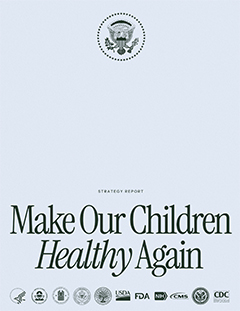Featured Activities are highlights of key activities, programs, and initiatives of the Task Force, its Subcommittees, and member federal departments and agencies that address children’s environmental health risks and safety risks. Featured Activities may include those of partner non-governmental organizations that are co-sponsored or have significant engagement of federal agencies. Inclusion as a Featured Activity does not imply any priority status but is meant to showcase the broad range of activities being taken by the federal government in Task Force priority areas.
Make Our Children Healthy Again Strategy
September 2025
On September 9, 2025, The Make America Healthy Again Commission released the Make Our Children Healthy Again Strategy, a sweeping plan with more than 120 initiatives to reverse the failed policies that fueled America’s childhood chronic disease epidemic. The strategy outlines targeted executive actions to advance gold-standard science, realign incentives, increase public awareness, and strengthen private-sector collaboration.
Chaired by U.S. Health and Human Services Secretary Robert F. Kennedy Jr., the Commission is tasked with investigating and addressing the root causes of America’s escalating health crisis, with a focus on childhood chronic diseases.
“The Trump Administration is mobilizing every part of government to confront the childhood chronic disease epidemic,” Secretary Kennedy said. “This strategy represents the most sweeping reform agenda in modern history—realigning our food and health systems, driving education, and unleashing science to protect America’s children and families. We are ending the corporate capture of public health, restoring transparency, and putting gold-standard science — not special interests — at the center of every decision.”
Key Focus Areas of the Strategy:
Restoring Science & Research: Expanding NIH and agency research into chronic disease prevention, nutrition and metabolic health, food quality, environmental exposures, autism, gut microbiome, precision agriculture, rural and tribal health, vaccine injury, and mental health.
Historic Executive Actions: Reforming dietary guidelines; defining ultra-processed foods; improving food labeling; closing the GRAS loophole; raising infant formula standards; removing harmful chemicals from the food supply; increasing oversight and enforcement of direct-to-consumer prescription drug advertising laws; improving food served in schools, hospitals, and to veterans; and reforming Medicaid quality metrics to measure health outcomes.
Process Reform & Deregulation: Streamlining organic certification; easing barriers to farm-to-school programs and direct-to-consumer sales; restoring whole milk in schools; supporting mobile grocery and processing units; modernizing FDA drug and device approval; and accelerating EPA approvals for innovative agricultural products.
Public Awareness & Education: Launching school-based nutrition and fitness campaigns, Surgeon General initiatives on screen time, prioritizing pediatric mental health, and expanding access to reliable nutrition and health information for parents.
Private Sector Collaboration: Promoting awareness of healthier meals at restaurants, soil health and land stewardship, and community-led initiatives, and scaling innovative solutions to address root causes of chronic disease.
With this strategy, the MAHA Commission leads the most ambitious national effort ever to confront childhood chronic disease and Make America Healthy Again.
“Protecting human health and the environment while powering America's comeback isn’t just about serving Americans today; it’s about ensuring future generations inherit clean air, land, water, and the foundation for healthy lives,” EPA Administrator Zeldin said. “The Make America Healthy Again strategy outlines the keys to success from pro-growth policies that advance research and drive innovation to private sector collaboration and increased public awareness. I look forward to continuing to work collaboratively across the federal family to ensure our kids and our environment are protected.”
Make America Healthy Again
March 2025
On February 13, 2025, President Trump issued Executive Order (EO) 14212: Establishing the President’s Make America Healthy Again Commission, to improve the health of Americans, particularly children.
This new EO contains provisions that complement the President’s Task Force on Environmental Health Risks and Safety Risks to Children’s establishing text, EO 13045: Protection of Children from Environmental Health Risks and Safety Risks. Both EOs seek to address environmental factors contributing to chronic diseases and other health impacts in children.
EO 14212 states: “To fully address the growing health crisis in America, we must re-direct our national focus, in the public and private sectors, toward understanding and drastically lowering chronic disease rates and ending childhood chronic disease.”
EO 13045 directs that “each Federal agency: shall make it a high priority to identify and assess environmental health risks and safety risks that may disproportionately affect children; and shall ensure that its policies, programs, activities, and standards address disproportionate risks to children that result from environmental health risks or safety risks.”
Both EOs recognize the need to address specific children’s health concerns including asthma and chemical exposures. The Task Force addresses these topics primarily through the work of its Asthma and Chemical Exposures subcommittees.
Both EOs also establish interagency structures to leverage the expertise of the federal government to address children’s health through a focus on primary prevention. The President’s Task Force structure comprises of a Steering Committee and topical Subcommittees whose members represent relevant federal agencies. The Make America Healthy Again Commission will work through its Chair, Executive Director, and participating federal agencies.
Further underscoring opportunities for collaboration, EO 14212 references the Federal Interagency Forum on Child and Family Statistics, which also was established under EO 13045 . The Forum membership comprises 23 Federal agencies and works to enhance and improve consistency in the collection and reporting of Federal data on children and families.
While EO 14212 takes a broader approach to addressing adverse health outcomes in children, the environmental health and safety focus of EO 13045 provides opportunity for highly complementary work to meet the President’s goal of improving the health of American children.
Read the Executive Orders:
E.O. 14212 Establishing the President’s Make America Healthy Again Commission
E.O. 13045 Protection of Children from Environmental Health Risks and Safety Risks


